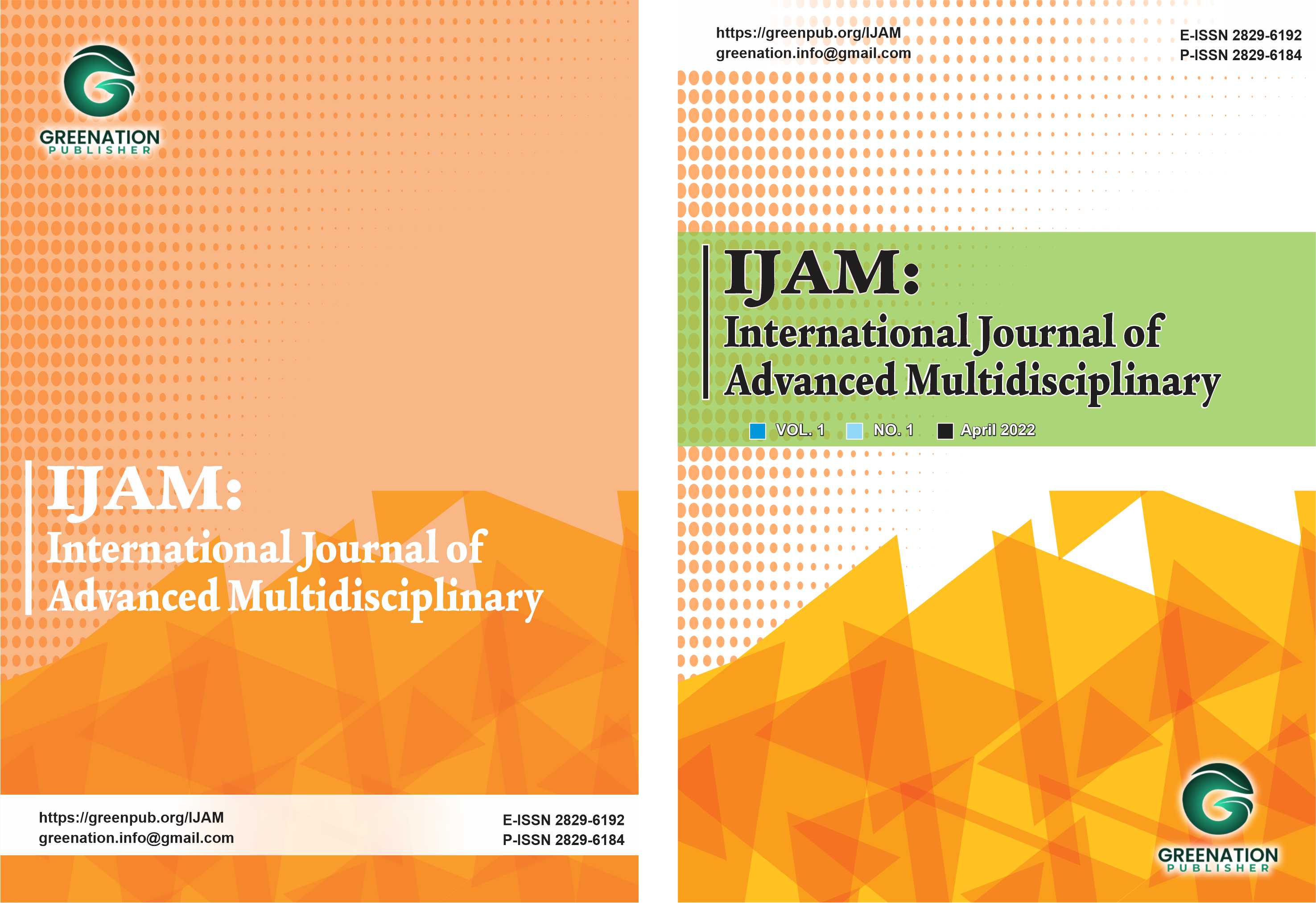Design of Control and Monitoring System for Electrical Power on kWh Meter Based on Internet of Things (IoT)
DOI:
https://doi.org/10.38035/ijam.v4i3.1365Keywords:
electricity theft, electricity monitoring, power control, Internet of Things (IoT), BlynkAbstract
Electricity theft is the illegal use of electrical power without proper authorization and payment. This act causes losses to the electricity provider and the public, poses safety hazards, and violates the law. Perusahaan Umum Daerah (PERUMDA) Tuah Sekata of Pelalawan Regency, as a regional-owned enterprise responsible for electricity distribution to the community, annually detects indications of electricity theft through field inspections. To simplify the identification process and reduce operational costs, an Internet of Things (IoT)-based device was designed to monitor and control customers’ electricity consumption.
The device utilizes a power supply as a 5V DC voltage source, a PZEM-004T sensor to measure voltage, current, power, and energy, an LCD 16x2 to display measurement results, and a 5V relay to connect or disconnect the customer’s power supply. An ESP32 microcontroller processes the data and transmits it via Wi-Fi to the Blynk application, which serves as an online monitoring interface.
The device developed in this study not only facilitates real-time monitoring of electricity consumption but also serves to detect and prevent potential electricity theft. The experimental results show that, for voltage measurements, the average percentage error obtained was 0.41% (Device IoT 1), 0.29% (Device IoT 2), and 0.38% (Device IoT 3). Meanwhile, for current measurements, the average error rates were 8.42% (Device IoT 1), 8.66% (Device IoT 2), and 8.60% (Device IoT 3). Based on the experimental results, it can be concluded that the three developed IoT devices have an error rate of less than 10% (classified as very good), making them feasible for use in monitoring electrical power consumption.
References
Agil, Fadlurrohman. (2023). Rancang Bangun Sistem Monitoring Konsumsi Energi Listrik Berbasis IoT Menggunakan Nodemcu (Skripsi). Universitas Islam Negeri Walisongo Semarang. https://eprints.walisongo.ac.id/id/eprint/25083/1/Skripsi_2008096050_Fadlurrohman_Agil.pdf
Amirah., Salman., Abidin, Zainal. (2023). Desain dan Implementasi Sistem Monitoring Pemakaian Daya Listrik Bagi Pelanggan Rumah Tangga Berbasis IoT. Cogito Smart Journal, 9 (2), 368-380.
Aprilianto, Moch. Duvan Rizky & Winardi, Slamet.(2023). Monitoring Daya Listrik Berbasis IoT di Era Metaverse. Jurnali Ilmu Komputer dan Bisnis (JIKB),XIV(2a), 51-61.
Basyarudin.(2019). Upaya PLN Dalam Mengatasi Pencurian Aliran Listrik (Studi Kasus di Kecamatan Siak Hulu Kabupaten Kampar)(Skripsi), Universitas Islam Riau. https://repository.uir.ac.id/6851/1/147510314.pdf
D. Mulyani and D. Hartono.(2018). Pengaruh EfisiensiiEnergi Listrik pada Sektor Industri dan Komersial terhadap Permintaan Listrik di Indonesia. Jurnal Ekonomi Kuantitatif Terapan,11(1),1-7.
Fari, A. M., Latifah, L., & Ibrohim, M. (2020). Modul Implementasi Internet of Things (IoT) Smart Garden Berbasis ESP32. Malang: BBPPMPV BOE Malang.
Hartono, Dwi Riyadi.,haddin, muhammad.,Marwanto, Arief. Monitoring Daya Listrik Berbasis Internet of ThingsMenggunakan Metode Simple Exponential Smoothing untuk Prediksi Kebutuhan Energi. Jurnal Teknik Elektro.6(2),59-67.
Hidayati, Noura.(2024). Rancang Bangun Sistem Monitoring Daya Listrik 3 Fasa Pada Laboratorium Listrik Berbasis Internet Of Things (Iot) (Skripsi). Universitas Islam Negeri Arraniry Darussalam, Banda Aceh. https://repository.arraniry.ac.id/id/eprint/40546/1/Noura%20Hidayati%20200211037%2C%20FTK%2C%20PTE.pdf
Irawan, M. D. (2022, Mei 27). Flowchart dan Pseudo-Code: Implementasi Notasi Algoritma dan Pemrograman. Retrieved from Google Books: https://www.google.co.id/books/edition/Flowchart_dan_Pseudo_Code_Implem entasi_N/c-txEAAAQBAJ?hl=id&gbpv=0
Kadir, Abdul. (2013). PengantariSistem Informasi Edisi Revisii .Yogyakarta: CV.Andi.
https://www.researchgate.net/publication/264422149_Pengenalan_Sistem_Informasi_Edisi_Revisi
Kho, D. (2022). Pengertian Tegangan Listrik (Electric Voltage). Retrieved from Teknik Elektronika: https://teknikelektronika.com/pengertian-tegangan-listrikelectric-voltage/
Maricar, M. Azman (2019). Analisa Perbandingan Nilai Akurasi Moving Average dan Exponential Smoothing untuk Sistem Peramalan Pendapatan pada Perusahaan XYZ. Jurnal Sistem dan Informatika, Universitas Udayana.
Meier, Alexander Von. (2006). Electric powerisystems: a conceptual introduction. United States of America : A Wiley-Interscience publication
Molen, Andre. (2020). Sistem Pengendali Mesin Air Otomatis Menggunakan Mikrokontroler Arduino(Skripsi). Universitas Islam Riau Pekanbaru. https://repository.uir.ac.id/11879/1/133510587.pdf
Munasirah, Andi.(2023). Rancang Bangun Sistem Kendali Lampu Otomatis Berbasis Iot Menggunakan Sensor Rcwl 0516 Dan Sensor Ldr(Skripsi). Program Studi Sarjana Teknik Elekro Fakultas Teknik Universitas Hasanuddin Gowa.
http://repository.unhas.ac.id/id/eprint/29089/1/D041181338_skripsi_07-06-2023%201-2.pdf
Muzakir, Ahmad. (2023). Sistem Monitoring Daya Listrik Internet Of Things (Iot) Menggunakan Algoritma Fuzzy Logic Sugeno Dan Firebase Berbasis Android (Skripsi). Universitas Islam Negeri Syarif Hidayatullah Jakarta. https://repository.uinjkt.ac.id/dspace/bitstream/123456789/72887/1/AHMAD%20MUZAKIR-FST.pdf
Nugraha ,Stefanus Gita Surya.(2024). Penerapan Proteksi Pada Kamar Kos Menggunakan Esp 32 Berbasis Internet Of Things (Iot)(Skripsi). Universitas Semarang. https://eskripsi.usm.ac.id/files/skripsi/C41A/2020/C.411.20.0048/C.411.20.0048-15-File-Komplit-20241011014637.pdf.
Nuwolo, A & Kusmantoro, A. (2015). Rancang Bangun Kapasitor Bank Pada Jaringan Listrik Gedung Universitas PGRI Semarang. Prosiding SNST (6) Fakultas Teknik Wahid Hasyim Semarang.
Onny, Apriyahanda.(2016). Pengertian Daya Semu, Daya Nyata, dan Daya Reaktif,.Retrieved from https://artikel-teknologi.com/pengertian-daya-semu-daya-nyata-dan-daya-reaktif
Pela, Maria Febrianti., Pramudita, Rully. ( 2021 ). Sistem Monitoring Penggunaan Daya Listrik Berbasis Internet Of Things Pada Rumah Dengan Menggunakan Aplikasi Blynk. Journal Of Technology Information,7(1),47-54.
Prayoga, Wahyu Eko. (2024). Sistem Monitoring Daya Listrik Dan Kontrol Perangkat Elektronik Rumah Tangga Berbasis IoT (Skripsi) Politeknik Negeri Jember. https://sipora.polije.ac.id/34245/
Putra, Hari. (2022). Analisis Sistem Monitoring Daya Listrik Menggunakan Internet Of Things ( IOT ) Pada Gedung Teknik Elektro Politeknik Negeri Bengkalis (Skripsi). Politeknik Negeri Bengkalis.
https://Repository.Unilak.Ac.Id/3162/1/1720201048_BAB-I_V_DAFTAR-PUSTAKA.Pdf
PZEM-004T v3 Datasheet, https://github.com/vortigont/pzem-edl/blob/main/docs/PZEM-004T-V3.0-Datasheet-User-Manual.pdf
Ramadhani, Muhammad Rafli. (2024). Sistem Monitoring Arus Tegangan Dan Daya Energi Listrik Berbasis Internet Of Things (Iot)(Skripsi). Universitas Satya Negara Indonesia Jakarta.
https://repository.usni.ac.id/repository/b60b0bc7336245cd68492110dc1 e8575.pdf.
Rifaldi, Muhammad.(2021). Penerapan Internet Of Things Pada Prototype Smart Home Menggunakan Pola Suara Dengan Mikrokontroler Nodemcu(Skripsi). Program Studi S1 Teknik Informatika Fakultas Teknik Universitas Islam Riau Pekanbaru.
https://repository.uir.ac.id/10607/1/143510410.pdf
Santoso, H. (2015). Panduan Praktis Arduino Untuk pemula. Trenggalek JawaTimur:www.Elangsakti.com. https://www.academia.edu/37963416/Belajar_Arduino_untuk_Pemula.
Setiawan, Irfan Okki. (2022). Sistem Monitoring Penggunaan Listrik Menggunakan Sensor Pzem – 004t Berbasis Internet Of Things (Iot)(Skripsi). Jurusan Teknologi Informasi Fakultas Teknologi Informasi Dan Komunikasi Universitas Semarang.
Sofwan, Agus (2025). Buku Metodologi Penelitian Pendidikan (Kuantitatif & Kualitatif). Saba Jaya Publisher.
Subito, Mery., Rizal.(2012). Alat Pengukur Pemakaian Energi Listrik Menggunakan Sensor Optocoupler Dan Mikrokontroler At89s52. Jurnal Ilmiah Foristek,2(2),184-189.
Suryantoro, Hery.(2019). Prototype Sistem Monitoring Level Air Berbasis Labview Dan Arduino Sebagai Sarana Pendukung Praktikum Instrumentasi Sistem Kendali. Indonesian Journal of Laboratory,1(3),20-32.
Widodo, Arif., Kholis, Nur., Rakhmawati, Lusia. (2022). Rancang Bangun Alat Monitoring Daya Listrik Berbasis IoT Menggunakan Firebase Dan Aplikasi Android. Jurnal Teknik Elektro,11(1),47-55.
Downloads
Published
How to Cite
Issue
Section
License
Copyright (c) 2025 Agus Sofwan, Abdullah Multi, Mohammad Azli, Nana Sujana

This work is licensed under a Creative Commons Attribution 4.0 International License.
Authors who publish their manuscripts in this journal agree to the following conditions:
- The copyright on each article belongs to the author(s).
- The author acknowledges that the International Journal of Advanced Multidisciplinary (IJAM) has the right to be the first to publish with a Creative Commons Attribution 4.0 International license (Attribution 4.0 International (CC BY 4.0).
- Authors can submit articles separately, arrange for the non-exclusive distribution of manuscripts that have been published in this journal into other versions (e.g., sent to the author's institutional repository, publication into books, etc.), by acknowledging that the manuscript has been published for the first time in the International Journal of Advanced Multidisciplinary (IJAM).























